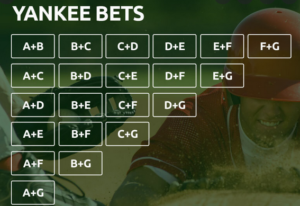What is a Yankee Bet?
 The Yankee is a common bet for most punters. If you haven’t chanced your arm betting on one, you’ve probably heard about it.
The Yankee is a common bet for most punters. If you haven’t chanced your arm betting on one, you’ve probably heard about it.
So what’s a Yankee?
Firstly, it has nothing to do with someone who lives in the United States of America. At least, I don’t think so. Not even a gambling man with a penchant for poker and trifecta (whatever that is!).
A Yankee bet consists of 11 equal value bets on four selections: six doubles, four trebles and one four-fold accumulator.
You can have a straight win Yankee or do it each-way (which covers the place too) that costs double the price.
A £1 straight win Yankee costs £11.
For example, if you got very lucky and bet on four selections at the following odds: 2/1, 3/1, 7/1 & 10/1.
You would win £2,133 (including your £11 stake). Nice work, hey.
If you backed four even money favourites you’d show a total profit of £61 to £1.
Other multi bets include: Lucky 15, Canadian, Heinz, Super Heinz, Goliath. In fact, multi bets allow you to select up to 25 different individual bets into one bet.
These are often employed by gamblers who follow football where the odds on individual matches are often short. Multi bets are a popular for the simple reason a gambler can stake a small amount of money with the hope of winning several hundred pounds if not thousands.
I always remember my Dad, while on holiday at Great Yarmouth, cheering home the last of his four winners in an each-way Yankee.
He won over £700.
 Timeform ratings first appeared in ‘Racehorses of 1947’, published in 1948, and ever since have provided a matter-of-fact means of comparing racehorses from different generations. Of course, it can be argued that ratings of any description, Timeform or otherwise, are simply a matter of opinion, but the findings make for interesting reading all the same.
Timeform ratings first appeared in ‘Racehorses of 1947’, published in 1948, and ever since have provided a matter-of-fact means of comparing racehorses from different generations. Of course, it can be argued that ratings of any description, Timeform or otherwise, are simply a matter of opinion, but the findings make for interesting reading all the same.